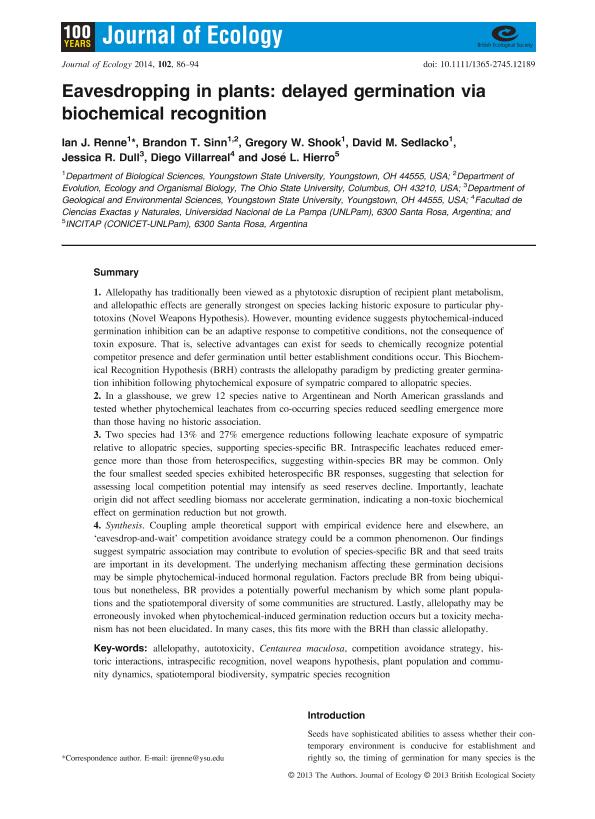Mostrar el registro sencillo del ítem
dc.contributor.author
Renne, Ian J.
dc.contributor.author
Sinn, Brandon T.
dc.contributor.author
Shook, Gregory W.
dc.contributor.author
Sedlacko, David M.
dc.contributor.author
Dull, Jessica R.
dc.contributor.author
Villarreal, Diego

dc.contributor.author
Hierro, Jose Luis

dc.date.available
2017-06-29T18:53:06Z
dc.date.issued
2014-01
dc.identifier.citation
Renne, Ian J.; Sinn, Brandon T.; Shook, Gregory W.; Sedlacko, David M.; Dull, Jessica R.; et al.; Eavesdropping in plants: delayed germination via biochemical recognition; Wiley; Journal of Ecology; 102; 1; 1-2014; 86-94
dc.identifier.issn
0022-0477
dc.identifier.uri
http://hdl.handle.net/11336/19161
dc.description.abstract
Allelopathy has traditionally been viewed as a phytotoxic disruption of recipient plant metabolism, and allelopathic effects are generally strongest on species lacking historic exposure to particular phytotoxins (Novel Weapons Hypothesis). However, mounting evidence suggests phytochemical-induced germination inhibition can be an adaptive response to competitive conditions, not the consequence of toxin exposure. That is, selective advantages can exist for seeds to chemically recognize potential competitor presence and defer germination until better establishment conditions occur. This Biochemical Recognition Hypothesis (BRH) contrasts the allelopathy paradigm by predicting greater germination inhibition following phytochemical exposure of sympatric compared to allopatric species.
In a glasshouse, we grew 12 species native to Argentinean and North American grasslands and tested whether phytochemical leachates from co-occurring species reduced seedling emergence more than those having no historic association.
Two species had 13% and 27% emergence reductions following leachate exposure of sympatric relative to allopatric species, supporting species-specific BR. Intraspecific leachates reduced emergence more than those from heterospecifics, suggesting within-species BR may be common. Only the four smallest seeded species exhibited heterospecific BR responses, suggesting that selection for assessing local competition potential may intensify as seed reserves decline. Importantly, leachate origin did not affect seedling biomass nor accelerate germination, indicating a non-toxic biochemical effect on germination reduction but not growth.
Synthesis. Coupling ample theoretical support with empirical evidence here and elsewhere, an ‘eavesdrop-and-wait' competition avoidance strategy could be a common phenomenon. Our findings suggest sympatric association may contribute to evolution of species-specific BR and that seed traits are important in its development. The underlying mechanism affecting these germination decisions may be simple phytochemical-induced hormonal regulation. Factors preclude BR from being ubiquitous but nonetheless, BR provides a potentially powerful mechanism by which some plant populations and the spatiotemporal diversity of some communities are structured. Lastly, allelopathy may be erroneously invoked when phytochemical-induced germination reduction occurs but a toxicity mechanism has not been elucidated. In many cases, this fits more with the BRH than classic allelopathy.
dc.format
application/pdf
dc.language.iso
eng
dc.publisher
Wiley

dc.rights
info:eu-repo/semantics/openAccess
dc.rights.uri
https://creativecommons.org/licenses/by-nc-sa/2.5/ar/
dc.subject
Allelopathy
dc.subject
Autotoxicity
dc.subject
Centaurea Maculosa
dc.subject
Competition Avoidance Strategy
dc.subject
Historic Interactions
dc.subject
Intraspecific Recognition
dc.subject
Novel Weapon Hypothesis
dc.subject
Plant Population
dc.subject
Community Dynamics
dc.subject
Spatiotemporal Biodiversity
dc.subject
Sympatric Species Recognition
dc.subject.classification
Ecología

dc.subject.classification
Ciencias Biológicas

dc.subject.classification
CIENCIAS NATURALES Y EXACTAS

dc.title
Eavesdropping in plants: delayed germination via biochemical recognition
dc.type
info:eu-repo/semantics/article
dc.type
info:ar-repo/semantics/artículo
dc.type
info:eu-repo/semantics/publishedVersion
dc.date.updated
2017-06-29T13:57:52Z
dc.identifier.eissn
1365-2745
dc.journal.volume
102
dc.journal.number
1
dc.journal.pagination
86-94
dc.journal.pais
Estados Unidos

dc.journal.ciudad
Hoboken
dc.description.fil
Fil: Renne, Ian J.. Youngstown State University; Estados Unidos
dc.description.fil
Fil: Sinn, Brandon T.. Youngstown State University; Estados Unidos
dc.description.fil
Fil: Shook, Gregory W.. Youngstown State University; Estados Unidos
dc.description.fil
Fil: Sedlacko, David M.. Youngstown State University; Estados Unidos
dc.description.fil
Fil: Dull, Jessica R.. Youngstown State University; Argentina
dc.description.fil
Fil: Villarreal, Diego. Universidad Nacional de La Pampa. Facultad de Ciencias Exactas y Naturales; Argentina
dc.description.fil
Fil: Hierro, Jose Luis. Consejo Nacional de Investigaciones Científicas y Técnicas. Instituto de Ciencias de la Tierra y Ambientales de La Pampa. Universidad Nacional de La Pampa. Facultad de Ciencias Exactas y Naturales. Instituto de Ciencias de la Tierra y Ambientales de La Pampa; Argentina
dc.journal.title
Journal of Ecology

dc.relation.alternativeid
info:eu-repo/semantics/altIdentifier/url/http://onlinelibrary.wiley.com/doi/10.1111/1365-2745.12189/abstract
dc.relation.alternativeid
info:eu-repo/semantics/altIdentifier/doi/http://dx.doi.org/10.1111/1365-2745.12189
Archivos asociados
